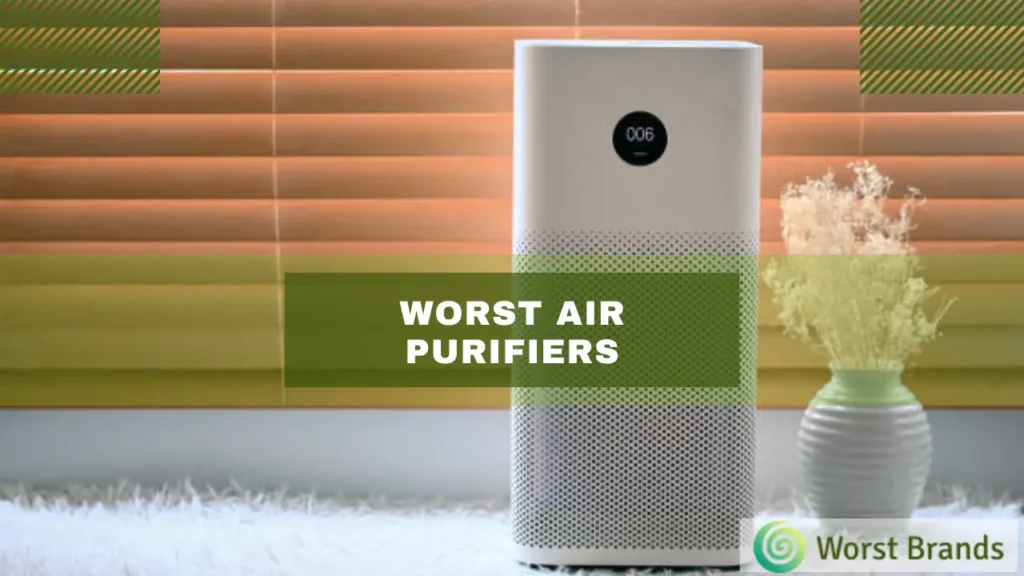Air purifiers can be life-changing. They can transform our living spaces into havens of fresh, clean air.
As you seek refuge from airborne pollutants and allergens, you’d assume every machine out there has your back. Unfortunately, that’s far from the truth.
There are some air purifiers to avoid entirely if you value your lungs and your wallet.
This is similar to the need to be cautious while selecting things for the home, such as avoiding certain mini-split brands, ceiling fans, humidifiers, or worse air fresheners.
After testing and collecting users’ feedback, we’ve prepared a list of the worst air purifiers on the market.
We’ll also give you tips on what to look for in a reliable machine.

Table of Contents
Worst Air Purifiers to Avoid
Based on our test results, the worst air purifiers to avoid are Molekule Air, ROSEKM, and Pure Enrichment. These devices fall short of improving air quality and removing pollutants.
1. Molekule Air
When I decided to try the Molekule Air purifier, I was intrigued by its strong social media presence.
The brand has patented PECO filter technology, which promises to eliminate pollutants at the nanoscale. The idea of a device capable of such feats was appealing.
After using it, however, I found that its performance in particle reduction was not as effective as I had hoped.
On its low-speed setting, it had difficulty reducing airborne particles. While there was some improvement in high speed, it still didn’t quite meet my expectations.
Considering its price of $800, coupled with an annual running cost of more than $170, I had anticipated more.
Molekule recommends this purifier for spaces up to 600 square feet. Still, based on my usage, I’d suggest it’s more suited for smaller areas, perhaps around 100 square feet.
While the Molekule Air has some interesting features, its performance in my home was not on par with its marketing claims.
2. ROSEKM Small Air Purifier
If you’re searching for a compact air purifier for personal spaces, you might have encountered the ROSEKM Small Air Purifier.
It promises a lot on paper: portability, a two-in-one purifier and diffuser functionality, and effective HEPA filtration.
However, its real-world performance doesn’t quite match its promises.
Despite its HEPA filtration claims, the device feels more akin to a basic computer fan, with limited air movement.
The build quality is a concern, with issues like non-functional charger ports and ineffective fan mechanisms reported.
Reaching out to the company for support appears to be another challenge.
Unresponsive emails, seemingly inactive customer service, and repeated hardware issues don’t offer a promising after-sales experience.
While the ROSEKM Small Air Purifier might look good and sound impressive in its description, its actual performance and reliability make it among the air purifiers to avoid.

3. Pure Enrichment Zone Halo
Upon researching air purifiers for smaller spaces, I came across the Pure Enrichment Zone Halo.
The company highlights its ability to cleanse up to 98% of dust and smoke in areas up to 100 square feet. Naturally, this claim piqued my interest.
After using the Zone Halo, its performance differed from the advertised promises.
At its highest speed, the purifier managed a decent job with dust. Still, its proficiency in removing smoke was less than satisfactory.
On its lower settings, the device struggled even further with dust and smoke removal, leaning more towards being a bad air purifier in terms of efficiency.
The Zone Halo operates with minimal noise, which I appreciate. Its energy efficiency was also commendable, marking a positive in its features.
However, I believe performance shouldn’t be compromised when the primary purpose is air purification.
While the Zone Halo has its perks, it might not be the first choice for those prioritizing optimal air quality.
4. Pure Enrichment PureZone Mini 2-in-1
The Pure Enrichment PureZone Mini 2-in-1 comes with an attractive price tag, making it a tempting option for those on a budget.
The company claims it can remove up to 98% of dust and smoke. However, in my experience, it didn’t quite meet those claims.
Both on its low and high settings, the device didn’t perform as effectively as anticipated in dust and smoke removal. Thus classifying it among the least reliable air purifiers.
On the plus side, its portability is a clear advantage. The rechargeable feature allows use in various settings like cars or planes.
Also noteworthy is its energy efficiency, resulting in a low annual operating cost of $29.
While its ambient noise can be soothing for some, if top-tier air purification is the goal, you might want to avoid this air purifier.
Why Some Air Purifiers Are Bad?
There are countless reasons why some air cleaners might not be worth your hard-earned cash:
- Poor Filtration Technology: A good air purifier should effectively remove pollutants. Some models, however, use outdated or ineffective tech that leaves harmful particles in the air.
- Noisy Operation: If it sounds like a jet engine in your living room, that’s a problem. This could be as frustrating as having one of the least reliable vacuum cleaners that makes so much noise.
- Excessive Costs: High costs don’t always equate to high quality.
- Short Lifespan: Some models just aren’t built to last.
Similar Blog: Worst Dehumidifiers
Final Thoughts
While these devices promise to improve indoor air quality and create healthier environments, it’s crucial to differentiate between genuine performance and worst air purifiers.
As we’ve explored, not all purifiers live up to their claims, with some falling short in areas like filtration efficiency, build quality, and customer support.
Always prioritize functionality over enticing price tags or flashy features to ensure the best value for your investment.
Remember, the goal is cleaner air, and not all devices are up to the task.

Crystal Hafley is a dedicated writer and content creator for WorstBrands, where she specializes in writing insightful reviews about kitchen appliances and fashion products.
With her expertise, Crystal provides readers with accurate and reliable information to help them make informed decisions about the brands and products they use every day. When she's not researching or writing, Crystal enjoys cooking and exploring the latest fashion trends.